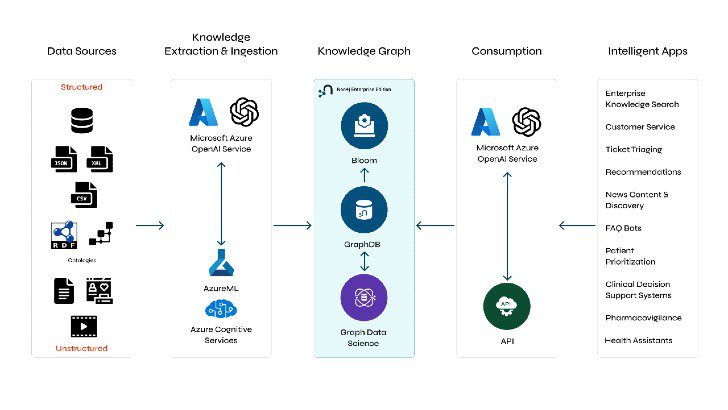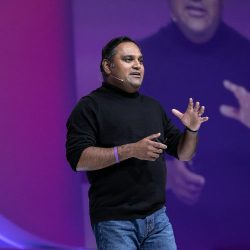
Arun Ulag, CVP of Azure Data, Microsoft, commented, “Microsoft is committed to empowering organizations with the tools and technologies they need to thrive in today’s data-driven world. Our collaboration with Neo4j represents a significant step forward in delivering innovative data solutions that will enable businesses to unlock new opportunities and drive digital transformation in the GenAI era.”
Neo4j is making available integrations with Microsoft Fabric and Microsoft Azure OpenAI. The native integration will enable Neo4j to combine structured and unstructured data held within the Microsoft stack.
Using the Neo4J graph database, customers can access even more hidden patterns and relationships contained within the new data sets they can access. The integration with Azure OpenAI Service is generally available now. The Microsoft Fabric integration will be generally available later this year.


Sudhir Hasbe, Chief Product Officer, Neo4j, noted, “We’re excited to combine Neo4j’s unparalleled graph capabilities alongside Microsoft’s seamless scalability, advanced AI capabilities of Azure OpenAI, and AI-Powered Analytics Platform with Microsoft Fabric.
“Enterprises can now unlock deeper insights, navigate complex data relationships, and drive better decision-making and innovation in ways that were not possible before. Together, we’re helping customers redefine what’s possible for their data in an increasingly interconnected GenAI world.”
The growth of Graph
The rise in the importance of graph technology has been rapid. Gartner (membership required) estimates that by 2025, it will be used in 80% of data and analytics innovations. This is a 70% increase from 2021. In its January 2024 report, it noted, “The ability to discover and document data use cases and help build knowledge graphs out of data uses is becoming a vital capability. It is the first step to resolving fragmented data management issues by enabling a GenAI-augmented data fabric.”
The intersection of graph technologies and generative AI opens up new use cases for generative AI. Combining these technologies enables organisations to extract pertinent data using generative AI. And feed it into the Neo4j graph database technology.
The Azure OpenAI Service enables organisations to build generative AI experiences. With a diverse set of prebuilt and curated models from OpenAI, Meta and beyond. The AI-powered Microsoft fabric platform provides organisations with features that include data engineering, data science, data warehouse, real-time analytics, data montoring and response and business intelligence.
What will the integrations deliver
The integration of the Neo4j graph database will provide customers with the following features:
Transform unstructured data into knowledge graph
Developers can use OpenAI Service to process unstructured data, structure it, and load it into a knowledge graph. Once in a knowledge graph, users extract insights leveraging Neo4j data visualization and query tools like Bloom or use Neo4j connector with Power BI for business intelligence (BI).
Enhance contextual understanding and explainability
With Neo4j’s GenAI functions, Azure OpenAI Service can be used for fully integrated GraphRAG applications, whereby LLM queries can be used against enterprise data in knowledge graphs.
GraphRAG is an enhanced form of Retrieval Augmentation Generation (RAG) whose results demonstrate intelligence or mastery that outperforms other approaches previously applied to private datasets. Enterprises can also use Gen AI orchestration platforms like LangChain and LlamaIndex to build intelligent GenAI applications.
Long-term memory for LLMs with vector embedding integration
Neo4j provides long-term memory for large language models by supporting native vector embeddings. Neo4j has inbuilt support for vector storage and search capability for intelligent GenAI applications. Developers can now natively use Azure OpenAI embedding APIs to create embeddings and store them in the Neo4j Database.
Graph-powered insights as part of Microsoft Fabric unified data platform
Microsoft Fabric customers can now use Neo4j Graph Database and Analytics capabilities to discover hidden patterns and relationships deeply, easily, and quickly. Developers can implement Azure Data Factory to ingest data from OneLake into Neo4j.
It allows them to extract data from Synapse Data Warehouse using the Neo4j data warehouse connector, and run Graph Data Science algorithms from Synapse Data Science Notebooks. Additionally, they can leverage Power BI to build interactive dashboards on Neo4j Knowledge Graphs.
Graph Analytics as native Fabric workload
Neo4j and Microsoft Fabric teams are working together to deliver Neo4j as a native workload for Graph Analytics on the Microsoft Fabric platform. This will enable users to access graph analytics workload directly from the Microsoft Fabric console. And create Graph models from OneLake data, analyze Graph data, run Graph Data Science Algorithms using Neo4j Bloom. Also they will be able to write back results into OneLake for a seamless end-to-end integration.
Enterprise Times: What does this mean
Organisations have barely scratched the surface of what generative AI can do for them. Most uses, such as summarisation and content creation, are simple level one solutions. It is where technology organisations combine, such as Neo4j’s data graph and Microsoft LLMS, that level two capabilities emerge.


























